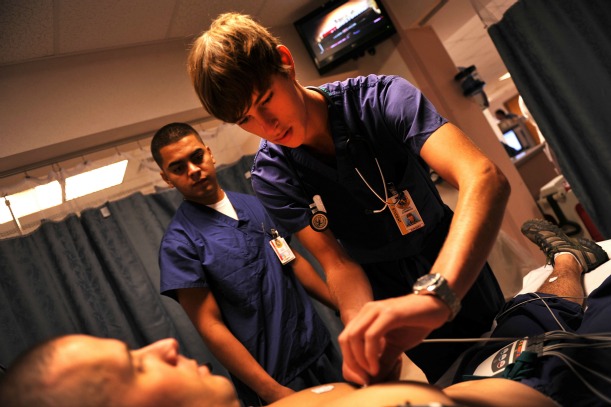The Life-Saving App That Sends Pictures of Your Heartbeat to Doctors
A new app outpaces email when sending crucial medical data from the ambulance to the hospital
![]()

Electrocardiograms, or ECGs, track the heart’s electrical activity through electrodes on the body. Photo: Mass Communication Specialist 2nd Class Gary Granger Jr./U.S. Navy
When you’re having a heart attack, every second counts. The tightness in your chest intensifies with each passing minute. The clotting blood in your coronary artery, blocked by plaque, steadily builds up. Deprived of oxygen-rich blood, parts of your heart muscle soon slowly begin to die. If surgeons don’t remove the blockage and restore blood flow in time, the clock runs out.
The faster a patient gets treatment, the better. That’s why many EMTs have started using smartphones to email hospitals pictures of electrocardiogram results—paper readouts of the patient’s heartbeat—while they’re still in the ambulance. But emails often take more than a few minutes to reach awaiting doctors, and an error message about a too-big file is the last thing first responders want to see.
To speed treatment, researchers at the University of Virginia bypassed email altogether. They have developed a smartphone app that transmits pictures of ECGs to hospitals in a matter of seconds. They presented their work this morning at the annual American Heart Association’s Quality of Care and Outcomes Research Scientific Sessions in Baltimore.
The team hopes the app will save the lives of patients suffering from a particular type of heart attack that causes heart muscle to die with the passage of time. During this type of attack—ST-segment elevation myocardial infarction, or STEMI—victims’ chances of dying increase by 7.5 percent with every 30 minutes they don’t receive treatment. Doctors can spot signs of a STEMI by studying the squiggly lines of an electrocardiogram printout, which shows the heart’s electrical activity and any of its irregularities.
To get this live-saving document to the emergency room, EMS personnel snap a photo of it with the app using an iPhone camera. The app, designed to maintain high-resolution quality, then compresses it to approximately 32 kilobytes. That’s a pretty small file: you could fit about 62,500 of them on a standard 2-gigabyte flash drive. Once the image has been shrunk, it’s divided into 16 parts, which are sent to the receiving hospital’s server over standard cellphone networks. There, the pieces are reassembled to form a complete image, which doctors can look at it in full using an online interface on their computers.
In 1,500 trials in the Charlottesville area, more than 95 percent of transmissions made it to the hospital in less than 25 seconds. The app consistently outperformed email, whether the cellphone network used was Verizon, Sprint or AT&T. Images were transmitted in four to six seconds, compared to 38 to 114 seconds for actual-size image files.
Both the app and email transfer times slowed when initial picture sizes were bigger or cellphone service petered out, but the STEMI app photo still reached hospital servers first. The trials showed the app had a failure rate of less than .5 percent, while rates for email ranged from 3 percent to 71 percent, depending on the network provider. Next, the researchers hope to test the STEMI app in rural areas, where cellphone service tends to be hard to find.
Mobile technology is making its way steadily into health care: it’s becoming common, for instance, for doctors and nurses to track patient charts on iPads. While the technology has been shown to improve physicians’ work flow, reports also suggest these tools can be a dangerous distraction. But in the field of medicine, most health care professionals can agree that faster emergency treatment, with or without the help of an iPhone, is always better.
More from Smithsonian.com:
Jury-Rigged iPhone Microscope Can See Parasitic Worms Just Fine
Smartphone as Doctor
/https://tf-cmsv2-smithsonianmag-media.s3.amazonaws.com/accounts/headshot/marina-koren-240.jpg)
/https://tf-cmsv2-smithsonianmag-media.s3.amazonaws.com/accounts/headshot/marina-koren-240.jpg)